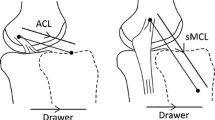Abstract
The meniscofemoral ligaments (MFL) of 26 human cadaver knees were studied to determine their structural importance. The incidence of at least one MFL in each of the specimens studied was 100%, and 46% of the specimens had both MFL ligaments (Humphry and Wrisberg). Another 23% had a single Humphry ligament, and the remaining 31% had a single Wrisberg ligament. A laser micrometer system was used to measure cross-sectional shape and area. The average cross-sectional areas of the Humphry and Wrisberg ligaments were 7.8±4.7 mm2 and 6.7±4.1 mm2, respectively. In specimens with both a Humphry and Wrisberg ligament, the larger ligament area was on average 100% greater than the smaller ligament area. The average ratios of the cross sectional areas of Wrisberg and Humphry to that for the PCL within the same knee were 12.0%±7.7% and 11.9%±5.7%, respectively. The structural properties of the MFL bone-ligament-meniscus complex and the mechanical properties of the MFL midsubstance were determined by uniaxial tensile testing. The average stiffness, ultimate load, and energy absorbed at failure were, respectively, 49.0±18.4 N/mm, 297.4±141.4 N and 1125.4±735.8 N/mm. The tangent modulus between 4% and 7% strain was 355.1±234.0 MPa. Our findings suggest that the MFL is a significant biomechanical structure in the knee because of its size, stiffness, and strength.
Similar content being viewed by others
References
Brantigan OC, Voshell AF (1946) Ligaments of the knee joint. The relationship of the ligament of Humphry to the ligament of Wrisberg. J Bone Joint Surg [Am] 28:66–67
Butler DL, Kay MD, Stouffer DC (1886) Comparison of material properties in fascicle-bone units from human patellar tendon and knee ligaments. J Biomech 19:425–432
Butler DL, Sheh MY, Stouffer DC, Samaranayaka VA, Levy MS (1990) Surface strain variation in human patellar tendon and knee cruciate ligaments. J Biomech Eng 112:38–45
Clancy, WG (1993) Posterior cruciate ligament. In: Chapman M (ed) Operative orthopaedics, Vol 3 pp 2093–2107
Friederich NF, O'Brien WR (1990) Functional anatomy of the meniscofemoral ligaments. Fourth Congress of the European Society for Knee Surgery and Arthroscopy (ESKA), June 25–27, 1990, Stockholm, Sweden
Fu F, Thompson W (1992) Motion of the meniscus during knee flexion. In: Mow V, Arnoczky S, Jackson S (eds) Knee meniscus: basic and clinical foundations. Raven, New York, pp 75–89
Harner CD, Livesay GA, Choi NY, Fujie H, Fu FH, Woo SL-Y (1992) Evaluation of the sizes and shapes of the human anterior and posterior cruciate ligaments: a comparative study. Trans ORS 17:123
Harner C, Kusyama T, Carlin G, Smith B, Livesay G, Morrow D, Woo SL-Y (1994) Structural and mechanical properties of the human posterior cruciate and meniscofemoral ligaments. Trans ORS 19:629
Heller L, Langman J (1964) The menisco-femoral ligaments of the human knee. J Bone Joint Surg [Br] 46:307–313
Last R (1950) The popliteus muscle and the lateral meniscus. J Bone Joint Surg [Br] 32:93–99
Lee T, Woo SL-Y (1988) A new method for determining cross-sectional shape and area of soft tissue. J Biomech Eng 110:110–114
Lee TQ, Danto MI (1992) Application of a continuous video digitizing system for tensile testing of bone-soft tissue-bone complex. ASME Adv Bioeng 22:87–90
Parolie J, Bergfeld J (1986) Long-term results of non operative treatment of isolated posterior cruciate ligament injuries in the athlete. Am J Sports Med 14:35–38
Parsons F (1900) The joints of mammals compared with those of man. Part II. Joints of the hind limb. J Anat Physiol 34: 301–323
Poirier P, Charpy A (1899) Traite d'anatomie humaine, vol 1. Masson, Paris
Vahey TN, Bennett HT, Arrington LE, Shelbourne KD, Ng J (1990) MR imaging of the knee: pseudotear of the lateral meniscus caused by the meniscofemoral ligament. Am J Roentgenogr 154:1237–1239
Woo SL-Y, Hollis J, Adams D, Lyon R, Takai S (1991) Tensile properties of the human femur-anterior cruciate ligamenttibia complex: the effects of speciment age and orientation. Am J Sprot Med 19:217–225
Woo SL-Y, Ohland K, Lee T, Newton P (1990) The use of a laser micrometer system to determine the cross-sectional shape and area of ligaments: a comparative study with two existing methods. Trans ASME 112:426–431
Author information
Authors and Affiliations
Rights and permissions
About this article
Cite this article
Kusayama, T., Harner, C.D., Carlin, G.J. et al. Anatomical and biomechanical characteristics of human meniscofemoral ligaments. Knee Surg, Sports traumatol, Arthroscopy 2, 234–237 (1994). https://doi.org/10.1007/BF01845594
Issue Date:
DOI: https://doi.org/10.1007/BF01845594




